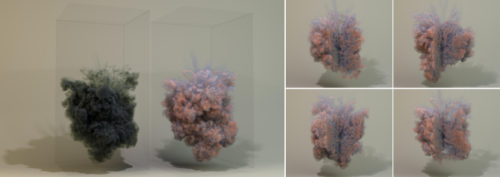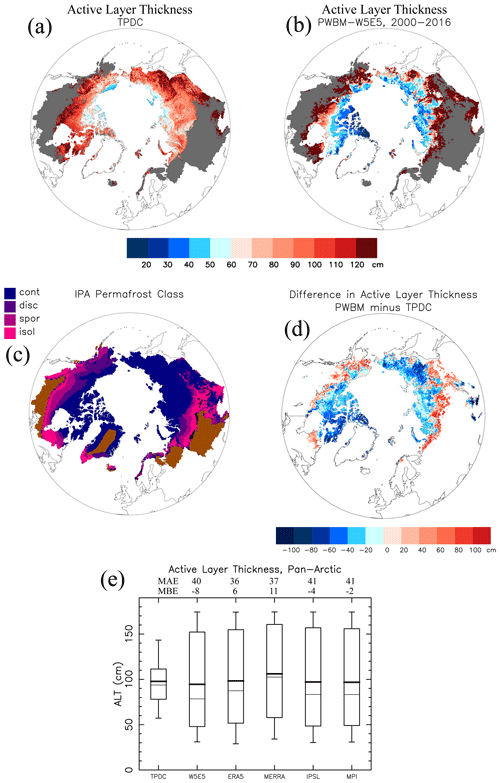2024-03-04 マサチューセッツ工科大学(MIT)
<関連情報>
- https://news.mit.edu/2024/tests-show-high-temperature-superconducting-magnets-fusion-ready-0304
- https://ieeexplore.ieee.org/document/10316632
- https://ieeexplore.ieee.org/document/10316582
- https://ieeexplore.ieee.org/document/10387711
- https://ieeexplore.ieee.org/document/10400852
- https://ieeexplore.ieee.org/document/10411128
- https://ieeexplore.ieee.org/document/10315227
SPARCトロイダル磁場モデルコイルの実験的評価とモデル検証 Experimental Assessment and Model Validation of the SPARC Toroidal Field Model Coil
D. G. Whyte; B. LaBombard; J. Doody; T. Golfinop ; …
IEEE Transactions on Applied Superconductivity Published:14 November 2023
DOI:https://doi.org/10.1109/TASC.2023.3332823
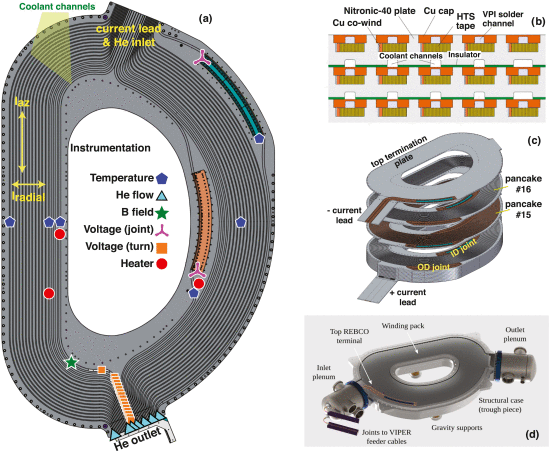
Abstract
In this article, the SPARC Toroidal Field Model Coil (TFMC) experimental tests are described. The tests include detailed comparisons to a hierarchy of electromagnetic and structural models of the coil. The tests confirm the ability of the no-insulation no-twist (NINT) configuration to provide highly stable dc operations with peak magnetic field in excess of 20 T at the rare earth yttrium barium copper oxide (REBCO) tape stacks. The advantages of the modular TFMC approach are validated including the ability to test and probe the REBCO and structural response of the coil in stages, a strategy that will be applied to large-scale coil production for SPARC. The electromagnetic models show high fidelity agreement to the dc and charging coil performance in terms of current distribution, voltages, and heating. The transient response of the TFMC to open-circuit events is examined. The coil exhibits the positive features of the NINT design with very low induced voltages and a predictable redistribution of current and resulting volumetric heating. However, highly localized damage occurs during a programmed open circuit at operational conditions similar to those used in the SPARC tokamak, in agreement with calibrated electromagnetic models. This reveals the cause and remedy to the thermal instability that gives rise to the damage. Therefore, the conclusion of the tests is that the NINT TFMC is confirmed as meeting the programmatic requirements for SPARC and, more generally, for high-field tokamaks.
SPARCトロイダル磁場モデル・コイル・プログラム The SPARC Toroidal Field Model Coil Program
Zachary S. Hartwig; Rui F. Vieira; Darby Dunn; The …
IEEE Transactions on Applied Superconductivity Published:13 November 2023
DOI:https://doi.org/10.1109/TASC.2023.3332613
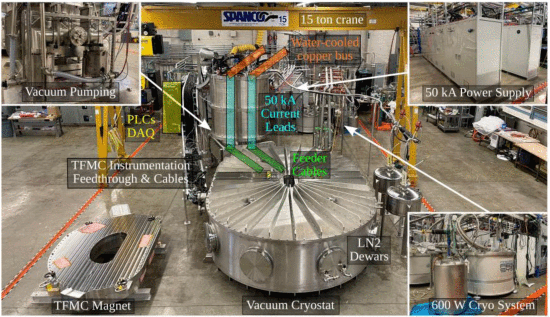
Abstract
The SPARC Toroidal Field Model Coil (TFMC) Program was a three-year effort between 2018 and 2021 that developed novel rare earth barium copper oxide (REBCO) superconductor technologies and then successfully utilized these technologies to design, build, and test a first-in-class, high-field (∼20 T), representative-scale (∼3 m) superconducting toroidal field (TF) coil. The program was executed jointly by the MIT Plasma Science and Fusion Center (PSFC) and Commonwealth Fusion Systems (CFS) as a technology enabler of the superconducting high-field pathway to fusion energy, and, in particular, as a risk retirement program for the no insulation (NI) TF magnet in the SPARC net-energy fusion tokamak. The TFMC achieved its programmatic goal of experimentally demonstrating a large-scale high-field REBCO magnet, achieving 20.1 T peak field-on-conductor with 40.5 kA of terminal current, 815 kN/m of Lorentz loading on the REBCO stacks, and almost 1 GPa of mechanical stress accommodated by the structural case. Fifteen internal demountable pancake-to-pancake joints operated in the 0.5 to 2.0 nΩ range at 20 K and in magnetic fields up to 12 T. The dc and ac electromagnetic performance of the magnet predicted by new advances in high-fidelity computational models was confirmed in two test campaigns while the parallel, single-pass, pressure-vessel style coolant scheme capable of large heat removal was validated. In the test facility, a feeder system composed of REBCO current leads and cables was experimentally qualified up to 50 kA, and a liquid-free cryocooler-based helium cryogenic system provided 600 W of cooling power at 20 K with mass flow rates up to 70 g/s at a maximum design pressure of 2 MPa for the test campaigns. Finally, the feasibility of using passive, self-protection against a quench in a fusion-scale NI TF coil was experimentally assessed. While the TFMC was intentionally not optimized for quench resiliency—and suffered localized thermal damage in response to an intentional open-circuit quench at 31.5 kA terminal current—the extensive data and validated models that it produced represent a critical step towards this important objective.
滑走路を作る SPARCトロイダル磁場モデルコイルのために作られた新しい超伝導マグネット試験設備 Building the Runway: A New Superconducting Magnet Test Facility Made for the SPARC Toroidal Field Model Coil
T. Golfinopoulos; P. C. Michael; E. Ihloff; A. Zhukovsk: …
IEEE Transactions on Applied Superconductivity Published:10 January 2024
DOI:https://doi.org/10.1109/TASC.2024.3352395
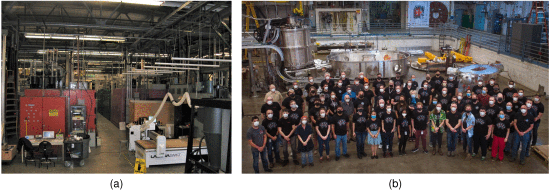
Abstract
A new superconducting magnet test facility was created at the MIT Plasma Science and Fusion Center (PSFC) for the SPARC Toroidal Field Model Coil (TFMC) program. The facility was designed and constructed in parallel with the TFMC between 2019 and 2021, with capabilities and design approaches tailored to the needs of this project and its time line. The major components of the facility include a new cryostat (outer dimensions, 5.3 m × 3.7 m × 1.5 m) with open bore; a novel cooling system circulating supercritical helium in a closed loop to provide ∼ 600 W cooling power at ∼ 20 bar-a, ∼ 20 K; a 50-kA ± 10-V power supply with supporting nitrogen-cooled high temperature superconductor (HTS) binary current leads operating at record currents, as well as VIPER-cable HTS cold bus; and a new instrumentation and programmable-logic-controller-based control system handling ∼ 650 input and output signals distributed between the facility and the test article. Substantial legacy infrastructure inherited from the PSFC’s Alcator C-Mod tokamak program, including liquid nitrogen facilities and 10 mW of ac power, was instrumental in the rapid deployment of these new systems. Immediately after initial commissioning, the facility was used successfully to test the SPARC TFMC, operating the magnet in a campaign achieving 20 T on the coil, as well as a second campaign performing quench testing. The facility has since undergone several upgrades and has been used in campaigns of other test articles, and it is expected that the facility will remain a resource for the community for the foreseeable future to develop fusion magnets and related technology.
SPARCトロイダル磁場モデルコイル用50kA容量、窒素冷却、脱着式電流リード線 50-kA Capacity, Nitrogen-Cooled, Demountable Current Leads for the SPARC Toroidal Field Model Coil
Vincent Fry; Alexander Zhukovsky; Michael J. Wolf; …
IEEE Transactions on Applied Superconductivity Published:16 January 2024
DOI:https://doi.org/10.1109/TASC.2024.3354237
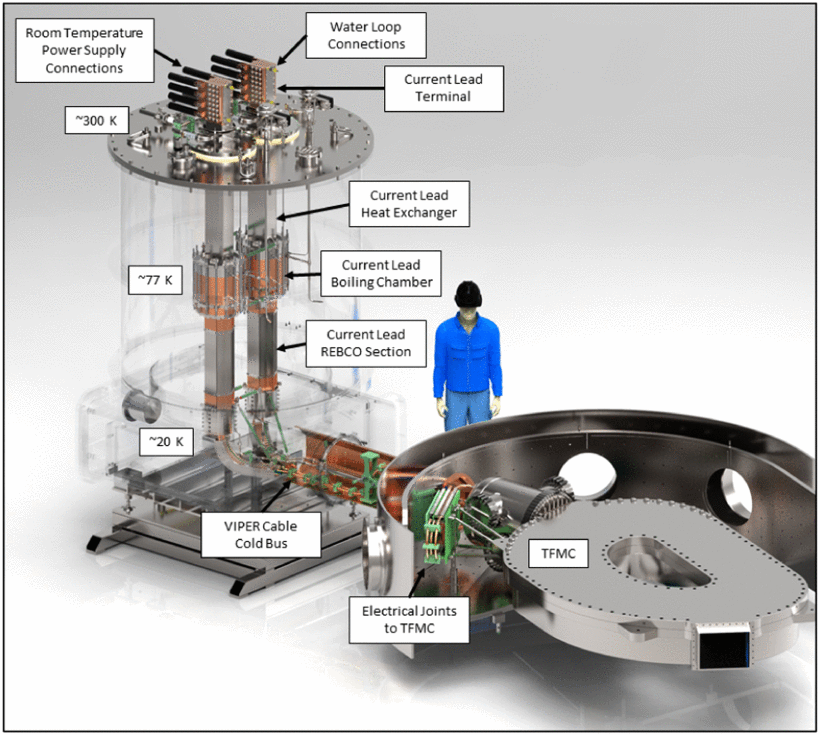
Abstract
This paper presents design, fabrication, and operational results for a novel pair of binary Current Leads (CLs). The CLs were purpose built for the SPARC Toroidal Field Model Coil (TFMC) Test Facility at the MIT Plasma Science and Fusion Center (PSFC). The CLs operate stably at current ramp rates up to 50 kA/s and steady-state currents of 50 kA from ambient temperature power supplies to the facility’s 20 K test environment. The CLs have three main sections: an upper copper heat exchanger (HEX) cooled with gas nitrogen (GN2) which connects to room temperature power supply (PS); a central liquid nitrogen (LN2) boiling chamber (BC) which vents into the HEX; and a lower Rare Earth Yttrium Barium Copper Oxide (REBCO) Section. The CLs have three distinguishing features: the BCs high surface area maintains <1 K temperature difference between their surfaces and the nucleate boiling LN2 within; each REBCO section is composed of six parallel “petals” that were individually qualified prior to installation; indium seals were used to simultaneously provide electrical continuity and hermetic sealing which enabled fabrication without need for braze or electron beam welding qualification processes. Additionally, the CLs can reduce the LN2 boiling pressure and thus temperature which significantly improves the temperature margins within the REBCO Section. The CLs were designed and built within 1.5 years and used successfully to deliver 40.5 kA of current to the SPARC TFMC. Since then they have been thermally cycled over 10 times and operated at both 1 atm and 0.65 atm.
SPARCトロイダル磁場モデルコイルの設計、製作、組み立て Design, Fabrication, and Assembly of the SPARC Toroidal Field Model Coil
Rui F. Vieira; David Arsenault; Raheem Barnett; Larr…
IEEE Transactions on Applied Superconductivity Published:22 January 2024
DOI:https://doi.org/10.1109/TASC.2024.3356571
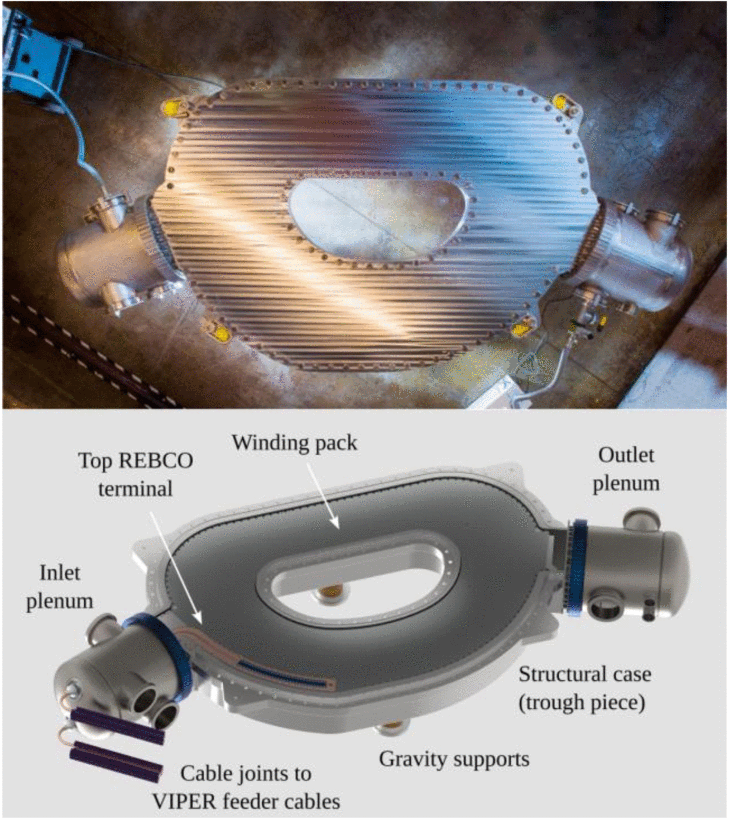
Abstract
The SPARC Toroidal Field Model Coil (TFMC) is the first large-scale (∼3 m), high-field (∼20 T) superconducting fusion magnet based on Rare Earth Yttrium Barium Copper Oxide (REBCO). Weighing 10,058 kg and utilizing 270 km of REBCO, the TFMC is a non-insulated, stack-in-plate style superconducting magnet. It has three main components: (1) the winding pack; (2) the structural case; and (3) the case extensions, or plena. The winding pack is composed of sixteen single pancakes with two termination plates top and bottom. The pancakes are Nitronic 40 radial plates machined with spiral channels on one side for the REBCO tape stack and single-pass channels on the opposite side for supercritical helium coolant. After assembly, each pancake undergoes a vacuum-pressure impregnation solder process to provide good mechanical protection of the REBCO tape stack and efficient thermal and electrical connectivity within each pancake. The pancakes are bolted along the inner and outer perimeter to provide mechanical and thermal connectivity while inter-pancake joints provide low resistance current transfer between pancakes. The top and bottom termination plates facilitate electrical connection to a superconducting feeder system. Embedded throughout the winding pack are 211 voltage taps, 34 temperature sensors, 34 helium flow monitors, 4 Hall probes, and 4 resistive surface heaters. The winding pack is contained within a structural case, a “trough and lid” style design composed of two Nitronic 50 forgings machined to shape and bolted together. The case reacts the large electromechanical stresses approaching 1 GPa during operation and serves as a pressure vessel that enables 20 bar supercritical helium flow that cools the winding pack and case. Two case extensions are attached to the case with unique high-pressure feedthroughs to provide winding pack access for current, cooling, and instrumentation, completing the magnet assembly.
SPARCトロイダル磁場モデルコイル計画用の20K、600W、クライオクーラーベースの超臨界ヘリウム循環システム A 20-K, 600-W, Cryocooler-Based, Supercritical Helium Circulation System for the SPARC Toroidal Field Model Coil Program
Philip C. Michael; Theodore Golfinopoulos; Ernest Ihlof…
IEEE Transactions on Applied Superconductivity Published:13 November 2023
DOI:https://doi.org/10.1109/TASC.2023.3332266
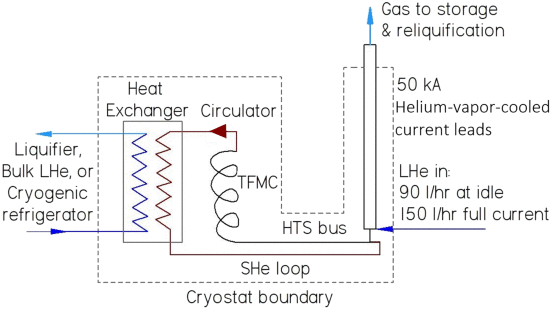
Abstract
From June 2019 to July 2021, the MIT Plasma Science and Fusion Center, in collaboration with Commonwealth Fusions Systems, designed, built, and commissioned a test facility at the Massachusetts Institute of Technology to evaluate the performance of a rare-earth-yttrium-barium-copper-oxide-based, 2.9-m tall, 1.9-m wide Toroidal Field Model Coil (TFMC) for the SPARC tokamak. This article presents the facility’s supercritical helium (SHe) circulation system design and measured performance. The facility employed a forced-flow SHe circulation loop cooled by cryocoolers to provide a nominal cooling power of 600 W at 20 K and up to 70 g/s SHe flow to the TFMC at an absolute pressure of 20 bar. The reliance on cryocoolers as the facility’s cooling source was an ideal arrangement. Procurement costs were modest, acquisition time was reasonable, and seating requirements were minimal. A steady improvement in cryocooler design provided a simple-to-use system with sufficient cooling capacity for our needs. Extensive, closed-loop analyses were performed both to support this procurement and to finalize the overall design of the SHe cooling circuit. The SHe system worked reliably, permitting flexible operation of the TFMC test facility under all working conditions.


